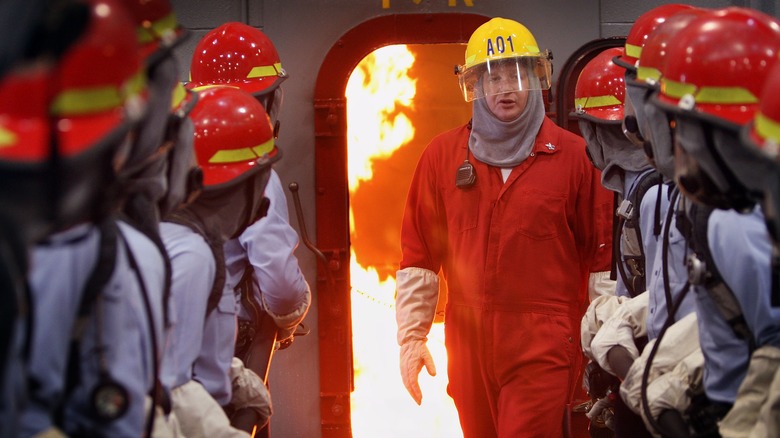The earliest boats to take to water up to the present day ships all share a common enemy. It’s not the weather, nor is it an enemy ship. It’s fire. Flames have been both a blessing and a curse to sailors the world over. It’s advantage can historically be found in such weapons as Greek Fire (think of it as napalm) or as fireships that helped Sir Francis Drake win against the Spanish Armada in 1588. Its curse, however, is that wooden ships were tinder boxes waiting to go up. Being made of dried wood and pitch maneuvered by canvas sails and highly flammable rigging made for a dangerous situation on the best of days, so how did early sailors fight fires?
Sailors for the majority of maritime history, up until the emergence of metal hulls, relied on several key sea firefighting processes and equipment. First, the U.S. Navy and the British Royal Navy both instituted firefighting drills which were rigorously performed. Next was the placement of sand and water barrels throughout the ship so as to be readily available should a fire break out. Finally, pumps could be brought to bear to fight a fire as well as draining the bilges if necessary. It wasn’t pretty, but it was what was available when sailing in a wooden matchbox.
Everyone fights fires on a ship

Scott Olson/Getty Images
The U.S. Navy’s metal fleet in WWII brought a plethora of enhancements to firefighting while adhering one inviolate rule: Every sailor is a firefighter. No matter the ship, wood or metal, a fire means serious trouble for everyone onboard, so every sailor was and is trained in firefighting. Sailors in WWII were organized into damage control teams and utilized hand-held fire extinguishers, water hoses and protein foam to fight fires. The method was to smother the fire at its source, using all of the tools available.
The years post-WWII would see the introduction of new tools to help fight shipboard fires due to amount of jet fuel (especially on carriers) and munitions that are typically carried. Protein foam was replaced by aquesous film-forming foam (AFFF) and dispersed through flush deck nozzels. Halon 1301 was installed in various ships in 1978 to fight machinery fires. This was a remote activated system; therefore, lives could be saved by not having sailors directly fighting the fire. Small engine and flight deck fires are fought with Halon 1211 which is disbursed through extinguishers, carts and hose lines.
How Naval firefighting evolved
Fires on modern ships are still a major concern, like the one that crippled the U.S.S. Bonhomme Richard near Naval Base San Diego in 2020. This incident sparked a focus on firefighting methods and changes to overall responsiveness. Senior Chief Petty Officer David Hafoka mentioned, «One of the big things that I know they’ve changed too is the requirements for roves, which is basically roving the ship and basically making sure everything is good to go. Before, it was kind of left up to the engineering duty officer and the fire marshal.» A sailor is now assigned to rove the ship every two hours, checking various locations and making sure that the ship is good to go in fighting a fire should one break out.
Specifically designated fire response sailors are helmed by a senior leader and are referred to as a «flying squad.» Should a fire break out, this squad would be one of the first on-scene to combat it. Efficiently supporting the «flying squad» and fighting the fires of today and tomorrow ends and begins with drilling. This drilling means conducting them as accurately as possible. This includes drilling in dark shipboard locations, conducting team rotations when fighting a fire (15-minute rotations is optimal), and conducting off-time drills as a fire can happen at any time. Sailors will always face the scourge of fire, but training, drilling, and technology will greatly stack the odds in their favor.